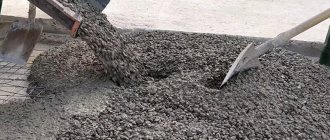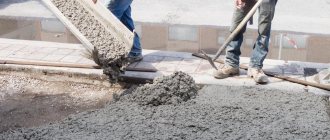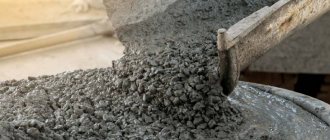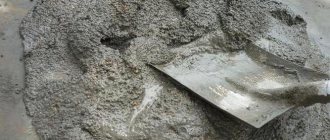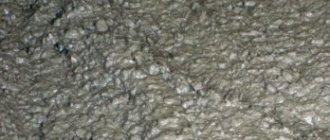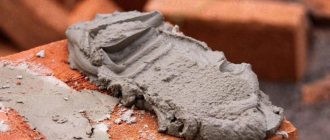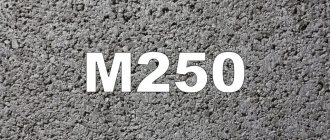- 1 M200 1.1 Composition
- 1.2 Proportions per cubic meter
- 2.1 Composition
Today, manufacturers of building materials offer a wide selection of concrete mixtures that are suitable for solving various problems. For all types of construction work, you can select a composition with cement of the required quality. In order for the concrete solution to acquire the necessary characteristics, you must adhere to the technology and the correct proportions. As an example, we can consider concrete M200 and M300 per meter cube (1m3). The brands of concrete mixtures correspond to their quality. In other words, the higher the brand, the higher the quality of the finished product or coating. Therefore, if this indicator is higher, then the cost of producing a mixture with a volume of 1 m3 is lower.
Application area
Concrete grade 200 is widely used in commercial and private construction:
- Arrangement of the concrete footing for the foundation when preparing the cushion. In this case, M200 concrete is used for weakened soils; less durable mixtures are usually used to level the litter.
- Installation of retaining walls with small height differences.
- Arrangement of monolithic strip and columnar foundations for small outbuildings and country houses with lightweight construction.
- Monolithic floor screed in warehouses and industrial, civil and residential premises with a maximum design load of no more than 200 kg/cm2.
- Improvement of garden paths, bicycle areas, sidewalk areas.
- Blind areas around buildings for any purpose.
- Production of prefabricated reinforced concrete elements: lintels, flights of stairs, curbs, paving slabs.
- Production of fence sections and installation of foundations for them.
Composition of concrete grade M200
The concrete solution must comply with the parameters prescribed by GOST 7473-94 “Concrete mixtures. Technical conditions". To do this, the components are mixed and then tested. When the solution hardens and completely hardens after 28 days, it can be considered from the point of view of another regulation - GOST 26633-2012 “Heavy and fine-grained concrete”.
Components for preparing concrete mixture:
- Portland cement grades M500, M400;
- Sand fraction 0.14…3.5 mm;
- Large filler. The crushed stone fraction for concrete should not exceed 50-70 mm.
Often the recipe for M200 concrete includes plasticizing additives that determine the individual properties of the mortar and the finished stone. For example, in the manufacture of road curbs and coatings, additives are added to the composition to increase the wear resistance of the stone; appropriate additives are used to improve water resistance - concrete itself in soil conditions is not able to resist a wet environment.
Binder requirements
The higher the quality, the lower the cement consumption. The lower the grade of cement, the more it will be needed to prepare the solution, so M500 binder is more often used in order to reduce costs. Along with it, M400 and M300 can be used, but the latter is not economically viable, although it is used in practice.
The hydraulic binder can be any:
- Portland cement is the most common and universal cement and has optimal technical characteristics.
- Romancement made from calcareous or magnesium marl with clay impurities up to 25%. This type is highly water resistant and is suitable for the manufacture of underground and above-ground structures.
- Slag Portland cement is resistant to humidity and aggressive environmental influences. It is optimal for the manufacture of foundation structures.
- Alumina is sulfate resistant and water resistant.
How much cement is in a m200 cube of concrete depends on the brand of binder. At the same time, it is important to maintain the water-cement ratio - the grout cannot be introduced “by eye”. The optimal ratio of water and binder is determined in the laboratory; it should be in the range of 0.3...0.5. If there is underfilling, the mixture will turn out dry and unmixed; if there is too much liquid, the concrete will not gain the required strength. To increase plasticity when it is insufficient, superplasticizers are introduced into the composition.
Sand
To ensure optimal filling of the solution volume, standards recommend using sand of fraction 0.14...3.5 mm. For construction purposes, it is better to take river sand - it is smooth with a minimum number of pores and sharp edges.
To mix concrete mortar, it is necessary to use purified fine filler - inclusions of mineral and organic origin ultimately reduce the strength of structures and contribute to its destruction from the inside. For this reason, conscientious miners and suppliers of garbage sift out or wash grains of sand from impurities, and only after that deliver the material to the customer.
Large filler
Crushed stone and gravel are necessarily included in any brand of concrete mixture - without them it is just a cement-sand mortar. The size of the stones is from 20 to 70 mm. The strength of concrete largely depends on their hardness, so crushed stone and gravel should be made of hard rocks; preference is given to granite and marble stones. They must be cleaned of foreign impurities, ideally washed with a stream of water and preliminary sifting of the debris.
Additives
Frost resistance, water resistance, increased strength and density are ensured by the introduction of additives into the concrete mortar. These are various mineral and chemical additives:
- Superplasticizers (type C-3) increase the mobility of the solution at a reduced w/c ratio. The strength, density of M200 concrete and resistance to water increases;
- Calcium and sodium compounds accelerate the hardening process for urgent construction;
- To slow down hardening, for example, when continuously concreting large volumes of formwork, retarders such as Bitron are introduced into the solution;
- Frost resistance is increased by additives such as MB 10 - they reduce the hardening temperature of the solution, which makes it possible to carry out winter concreting without organizing the insulation of the formwork and without losing the quality of the structures. In the future, the material more easily perceives temperature changes.
The total amount of all additives should not exceed 5% by weight of the dry binder component.
Installation recommendations
Pouring concrete onto the prepared area should be done from a height of no more than a meter. Otherwise, the material may delaminate and become unusable. The available volume of concrete mixture must be worked out within 3-4 hours after preparation, since then the first stage of cement hydration (thickening) begins. When laying a thick layer, it is recommended to compact the concrete to eliminate air cavities that form in its structure. This procedure can be performed manually, using a shovel, crowbar, reinforced rod, or mechanically, using special vibration devices.
Preparation of concrete solution
Concrete grade M200 requires compliance with proportions when preparing the solution. The number of components depends not only on the expected volume of the mixture, but also on the brand of cement used.
Standard proportions for preparing m200 concrete are given in the table:
| Cement brand | Proportions by weight in kg | Proportions by volume in liters | ||||
| Cement | Sand | Crushed stone | Cement | Sand | Crushed stone | |
| M300 | 1 | 1,8 | 3,3 | 10 | 16 | 30 |
| M400 | 1 | 2,8 | 4,8 | 10 | 25 | 42 |
| M500 | 1 | 3,5 | 5,6 | 10 | 32 | 49 |
Proportions of cement, sand and crushed stone in buckets (10 liters): 1 bag of 50 kg of binder, 6 fine and 14 coarse fillers.
Material consumption per 1 m3:
- 360 kg of M300 cement, 665 kg of sand, 1173 kg of crushed stone;
- 286 kg of M400 cement, 795 kg of sand, 1080 kg of crushed stone;
- 220 kg of M500 cement, 770 kg of sand, 1232 kg of crushed stone.
In all cases, water should not exceed 20% of the total mass of the dry mixture.
How many bags of cement in m200 concrete:
- M500 binder will need 4 bags of 50 kg and one of 25 kg or 5 bags of 50 kg (with remainder);
- M400 cement requires 6 bags of 50 kg or 5 of 50 kg and 1 of 40 kg;
- M300 cement will require 7 bags of 50 kg + 1 of 25. This is the most uneconomical option for purchasing components.
The proportions of concrete m 200 must be observed as accurately as possible, choosing a convenient measure (kg, liters or buckets). Only if this condition is met, the compressive strength of the finished structure will be expected, as well as other parameters.
To produce grade 200 concrete, you will need a self-contained concrete mixer. You can knead manually, but the quality of the solution in this case will not be ideal.
Sand and crushed stone are combined, cement is added, then water is poured in and mixed thoroughly. The mixture is prepared in batches as needed. For pouring large volumes, it is advisable to order the solution from the factory - M200 sets quickly and between batch batches the concrete placed in the formwork begins to gain strength, and inhomogeneities form in the structure.
Proportions per cube
To obtain the correct consistency, you should know the following information:
- required strength of the material;
- proportions;
- required ductility;
- brand of cement;
- properties of fillers.
To get 1 cubic m200, you need to take the following quantities of components:
- cement 330 kg - 0.25 m³ (with a bulk density of 1300 kg/m³);
- crushed stone 1250 kg - 0.9 m³ (1250 kg/m³);
- sand 600 kg - 0.43 m³ (1400 kg/m³);
- water 180 l - 0.18 m³.
Characteristics
The suitability of the material can be judged by the results of laboratory tests of freshly prepared mortar and hardened samples. In private construction, such events are carried out extremely rarely, but in the construction of commercial buildings they are mandatory.
Technical characteristics of concrete m200:
- volumetric weight of the solution is 2300…2400 kg/m3, depending on the size and density of crushed stone;
- concrete class b15 corresponds to grade M200;
- compressive strength at the age of 28 days – about 198 kgf/cm2;
- mobility of solution P2...P4 at a water-cement ratio of 0.3...0.5;
- weight of 1 m3 of the finished structure is 2300…2400 kg;
- frost resistance within F50-F150;
- water permeability W2…W6;
- setting time (start of hardening) is no earlier than 1 hour, the end of hardening depends on the ambient temperature and can vary within 6 hours...2-3 days. Drying time (complete hardening) – 28 days.
The specific gravity of concrete m200 is an unstable value for different batches of this material. I influence her:
- fraction of fillers (sand and crushed stone);
- the amount of introduced water and additives intended to compact the mixture by expelling air bubbles and filling them with binders and filler;
- quality of mixing components.
The weight of a cube of concrete prepared using the technology in a concrete mixer is 2400...2400 kg/m3. The error occurs due to crushed stone (different shape and weight of batches). When mixing by hand, even greater inaccuracies can occur, often to a lesser extent - ordinary people can end up with a solution with a mass of one cube of up to 2000 kg. Of course, such a mixture after hardening will not meet the stated technical characteristics.
When calculating projects, experts do not guess how much a cube of concrete weighs; they use the standard value of 2300 or 2400 kg/m3, unless other data is available.
Advantages and disadvantages of M200 concrete
Concrete M200 class B15 is a universal building material with a number of advantages:
- the optimal solution for one-story suburban construction - concrete can be used to install the foundation for a country house or frame house, outbuildings and arrangement of paths, areas for cars;
- rapid strength gain;
- high frost resistance, similar to higher concrete solutions;
- shrinkage occurs without deformation of the structure, without cracking the walls;
- work must be carried out at air temperatures above +5°C; when additives are introduced, the temperature threshold drops; winter concreting can be carried out.
Disadvantages arise as a result of violations of the technology for preparing the solution:
- when a large amount of water is introduced, the structure of the stone is disrupted and it does not gain the necessary strength;
- The water resistance of M200 concrete is low; when installing the foundation, it is necessary to provide additives that increase this indicator and high-quality waterproofing.
Advice from professionals
To give you a better idea of the main stages of work, we have prepared several useful video clips. These materials also contain advice from experienced builders to make it easier to mix the mortar, properly organize the concreting process and achieve high quality of the resulting mortar:
In order for concrete M200 to meet the stated parameters of strength and frost resistance, high-quality components should be used and the technology of mixing the solution should be strictly followed. Then the results of concreting will exceed all expectations. Good luck with your work!
